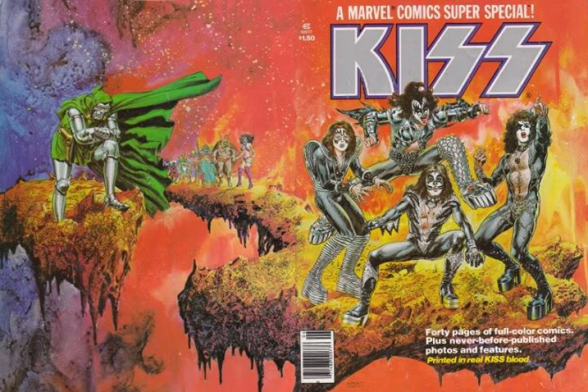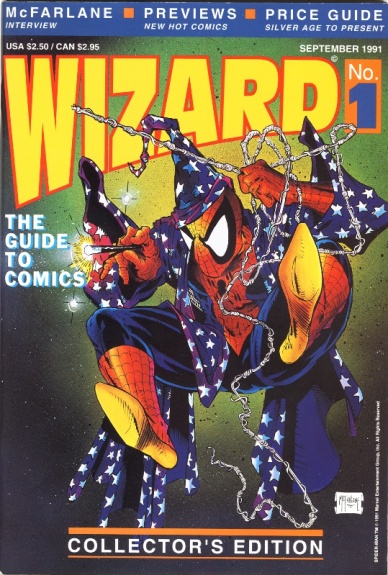Multiversity’s history column returns with new items from 1941, 1977, 1991, and 1995. SEE! The first comic for girls. SEE! A comic printed in blood. SEE! The debut of “Wizard” magazine. SEE! Todd McFarlane made to look bad on national TV. Enjoy!

In 1941, the Parents Magazine Institute decided to take a stand against the crushing wave of comics filled with escapist fantasy aimed at children. Unlike most detractors of the material however, PMI head honcho George J Hecht subscribed to the “if you can’t beat them, join them” philosophy. Thus, in April 1941, the publisher of Parents Magazine introduced the first educational comic book, “True Comics”. The 64-page anthology covered all the bases, from historical events to scientific discoveries, to inspiring individuals. It was an instant hit with sales around 300,000 copies in just ten days. The obvious appeal naturally led to spin-offs with more specific focuses.
The first spin-off was “Calling All Girls”, the first comic book aimed specifically for girls. The first issue, cover dated September 1941, was another 64-page anthology, but only half of that was actual comic content. The other half was prose tips on dating and fashion. It was another instant hit and inspired spin-offs of its own. For a short time, PMI tried to corner the market on girl readers with the comics “Sweet Sixteen” and “Polly Pigtails”.
For a time, PMI saw nothing but success, although some sources speculate sales were high only because parents were buying the comics for their kids, not because kids actually wanted the comics. By the end of the decade, the public debate on comics had turned decidedly sour and sales dropped below sustainable levels. In 1949, PMI ceased newsstand distribution and the final issues of its many titles were only received by subscribers in 1950. “Calling All Girls” vanished after issue 89, cover dated September 1949, but its numbering and some content continued in magazine format as “Senior Prom”.

After more than a year of negotiations and effort, Marvel released the magazine-sized “Marvel Comics Super Special #1” starring the hard rock musicians of KISS as superheroes. The larger format and higher production value prompted a larger cover price ($1.50 when most comics were still $0.30), but the band’s devoted following still led to sales over 500,000 copies.
The big news about the special was KISS adding some of their blood to the red ink at the printing facility. The stunt was photographed and legally affirmed by a notary witness (although later reports said the ink was mistakenly used for an issue of “Sports Illustrated” instead). The cover proudly proclaimed it was printed in real KISS blood.
Behind the scenes, writer Steve Gerber worked hard to keep the project on track as Stan Lee and other Marvel executives failed to understand the significance of the band. Among other things, he talked them out of dropping the license and creating a similar property they could own outright. Eventually, he was even able to secure a royalty for himself a year before Marvel instituted a standard royalty program.

In 1988, the Shamus family opened their own comic shop, The Wizard of Comics and Cards. One of their sons, Gareb, started a store newsletter for regulars that informed them about upcoming comics and what back issues were popular. He and co-editor/store employee Pat McCallum both enjoyed the effort and dreamed of producing a monthly price guide for comics like the “Beckett” guide for sports cards.
They discussed their plans with Walter Wang, the co-owner of the regional distributor Comics Unlimited, who advised them to include editorial content as well. Neither of them had much confidence to do that alone, so they hired a veteran editor of “Comics Scene”, Patrick Daniel O’Neill, to help them. Both Shamus and McCallum were in their very early twenties, and they wrote for people of similar age or younger. This set them apart from other fan-targeted comic magazines like “The Comics Journal”, “Amazing Heroes”, or “Comics Buyer’s Guide”, which all competed for the adult reader. They named their new magazine “Wizard” after the family store.
By luck, the Shamus family knew Todd McFarlane from store signings. He had drawn a sketch of Spider-Man for the youngest Shamus son’s birthday, which Gareb secured permission to use as a cover. At the same time, McFarlane agreed to an interview as well. That gave the first issue some appealing content, but it wasn’t an immediate hit. The team went to SDCC to hand out ashcans but they had a frustrating time trying to give them away. For some reason, con-goers were turning down the free copies.
Continued belowThe first issue hit newsstands and comic shops with a September 1991 cover date, but sales weren’t that great. Sales continued to drop month after month until the magazine was near the point of being a loss. Just as “Wizard” was about to fold, they polybagged their tenth issue with an exclusive “Youngblood” trading card by Rob Liefeld. That attracted a lot of eyes, and those fresh eyes liked what they saw.
Unlike the “Overstreet Price Guide” which limited the inclusion of new releases, “Wizard” offered a price guide that was as close to real time as they could manage. That meant new comics could be included less than two months after release, and prices could be very volatile. This catered to – and grew – the speculation crowd. Sales of “Wizard” grew sharply after that, and it was popular enough to garner 1.69% of the market by piece share by December 1992. By that time, a mere mention in “Wizard” could push a title higher in the sales charts.

In March 1995, Image shipped “Spawn” #30. The story was about Spawn encountering the KKK as they lynched a black man. At the end, Spawn uses his powers to turn the KKK leader into a black man, who is then unwittingly lynched by his friends. Overall, a positive message told in the ironic style of The Twilight Zone and EC Comics.
Naturally, not everyone got it.
A mother in North Dakota was particularly upset when she found her son reading it, and she made a fuss about it in the local newspaper and other outlets until it was picked up by the nationally syndicated tabloid TV show “A Current Affair”. The segment aired September 5, 1995, and much of the criticism appeared to come from barely-informed pundits who didn’t realize Spawn himself was black before Satan sent him back to Earth looking like a burn victim. In fact, the show only acknowledged the first half of the issue where the KKK are unchallenged and omitted the end, where they are shown as the obvious villains of the piece. You can view the piece yourself here.
McFarlane was invited to defend himself, but after it was aired he claimed his words were edited to make him look bad. McFarlane was not know for being eloquent and consistent with his messaging at the time, but in this case I’m inclined to believe the producers did him no favors. In true Todd style, he later turned the cover into a toy.






